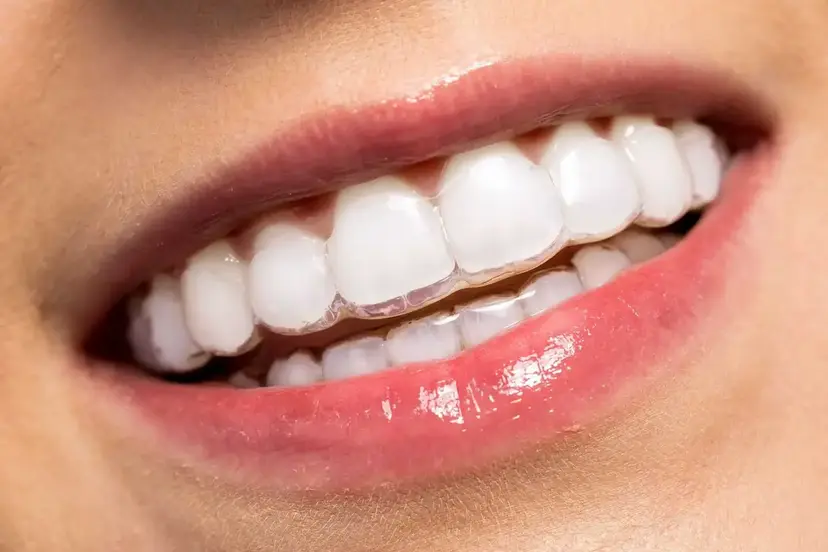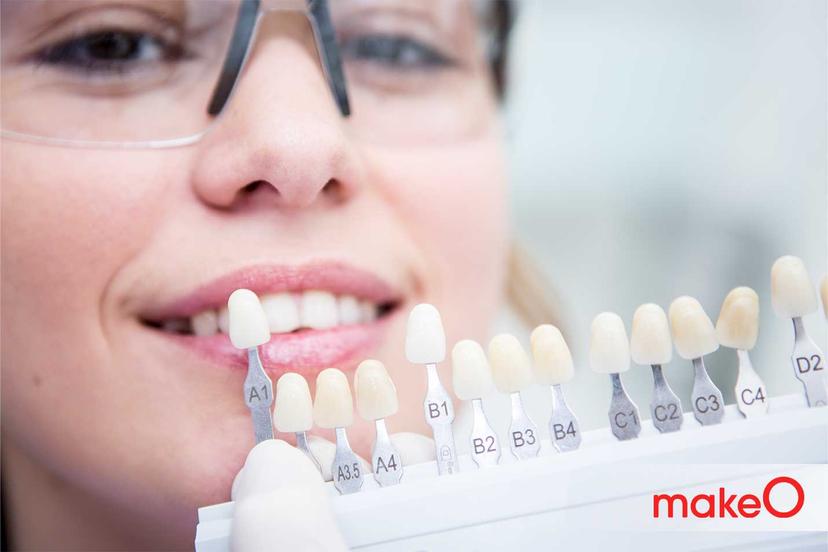MakeO blog
Introduction
Oral hygiene is a vital aspect of overall health that should never be neglected. It involves maintaining the mouth's cleanliness and caring for teeth and gums.1,2 Keeping your teeth and gums clean helps prevent problems like cavities, gum disease, and bad breath. A common result of poor oral hygiene is teeth discolouration. Things like coffee, smoking, or certain medications can cause yellow or brown stains. But we can keep our teeth bright and healthy with the right habits.
In this blog, we will look closer at how plaque and tartar cause staining, foods and habits that affect tooth colour, and simple oral hygiene tips to prevent and even reverse discolouration.
How does Poor Oral Hygiene Contribute to Tooth Discolouration?
Tooth discolouration occurs when teeth change colour, which can be classified into two types: extrinsic and intrinsic stains.
Intrinsic stains happen inside teeth due to tooth development problems, genetic conditions, metabolic issues, certain medicines, too much fluoride, tooth damage or decay, and materials like dental fillings. Extrinsic stains are found on the outer surface of the teeth, while intrinsic stains are deeper within the tooth structure.
Extrinsic stains are caused by things like food, drinks (coffee, tea, berries), tobacco, and certain medications. These substances leave pigments that stick to the surface of the teeth. Poor oral hygiene is one common cause of extrinsic stains, which form when plaque, food particles, and bacteria accumulate on the surface of the teeth. This buildup, if not regularly cleaned, can lead to yellow or brown stains over time. Extrinsic stains are also often caused by things we eat and drink, such as coffee, tea, berries, and tobacco. These substances contain pigments that can stick to the plaque on your teeth. Plaque itself can also trap and hold on to these staining agents, making them harder to remove. When plaque is not removed through brushing and dental flossing, it creates a sticky film that attracts stain-causing substances, making the teeth more prone to discolouration.4,5 Maintaining good oral hygiene is essential for preventing tooth discolouration.
The Role of Plaque and Tartar in Staining Teeth
Plaque and tartar play an important role in causing stains on teeth. Plaque is a sticky colourless film made up of bacteria and food particles that form on your teeth and it results in tooth discolouration. It makes your teeth feel "fuzzy," like tiny sweaters. If not removed by brushing and flossing, plaque hardens into tartar, which can only be removed by a dentist. Tartar starts as off-white or yellow, but over time, it can turn darker from things like coffee, tea, and smoking. Both plaque and tartar can impact the colour of your teeth by affecting the enamel, the outer layer that protects your teeth.
Plaque produces acids that weaken the enamel and make it more porous and prone to intrinsic staining. It can cause small white spots, indicating early enamel damage and the beginning of dental caries. Moreover, if plaque and tartar continue to build up, they can cause more visible discoloration such as black, brown, or green extrinsic stains. These stains are often caused by specific bacteria, such as Lactobacillus and Actinomyces, that produce pigments when they interact with substances in saliva. Tartar, being much harder to remove, is a key factor in the persistence of these stains. This buildup of plaque and tartar is a primary cause of tooth discolouration.
Foods, Drinks, and Habits That Impact Tooth Colour
Certain foods, drinks, and habits can cause stains that change the colour of your teeth. Direct staining happens when items like coffee, tea, red wine, or smoking leave colour particles that stick to your teeth. These particles mainly attach to the thin layer on your teeth, called the pellicle. Indirect staining occurs when products like mouthwashes or medicines, though they do not have colour, cause your teeth to stain when combined with food.
Here are some common food, drink, and habit-related causes of tooth staining:
Red Wine: Red wine has strong colours that can stain your teeth, making both natural teeth and fillings look different.
Tobacco Use: Smoking and chewing tobacco cause yellow or brown stains on your teeth that are hard to remove and worsen over time.
Electronic Cigarettes (EC): E-cigarettes can cause lighter stains, but over time, they can still affect your tooth colour.
Coffee and Tea: These drinks are dark and can cause stains that brushing alone might not remove.
Soy Sauce and Dark Sauces: Dark sauces like soy sauce can stain your teeth, and regular brushing may not get rid of the stains.
These foods, drinks, and habits can change the colour of your teeth and make them look stained making your oral health and hygiene poor.
Effective Oral Hygiene Practices to Prevent and Reverse Discolouration
To prevent and reverse tooth discolouration, it is essential to maintain good oral hygiene and make informed choices. Here are key practices:
Brush Regularly: Brush your teeth two to three times a day with a soft-bristled brush and fluoride toothpaste to remove plaque and stains Since stains stick to plaque, brushing regularly helps keep your teeth white. If plaque is not removed, it can cause your teeth to stain.
Floss Daily: Floss or you can also do interdental brushing once a day to clean between your teeth, removing food particles and plaque that brushing may miss. Flossing before brushing is helpful because it removes more plaque, which, if left, can lead to staining.
Limit Staining Foods: Reduce consumption of staining foods and drinks, such as tea, coffee, cola, and red wine. Drink water after consuming them to rinse away stains.
Stay Hydrated: Drink plenty of water to help wash away food and bacteria that contribute to staining.
Quit Smoking: As smoking can cause significant tooth discolouration, quitting will help maintain a brighter smile.
Regular Scaling: Professional teeth cleaning removes plaque, tartar, and stains, helping prevent gum disease and improving teeth appearance. Getting regular teeth scaling at Toothsi will help you get rid of tough stains on teeth and prevent their build-up.
Use Whitening Kits: If using over-the-counter whitening products, consult your dentist first to ensure they are safe and effective. Always choose reputable products for the best results.
Following these tips helps protect your teeth and maintain their natural whiteness by taking care of oral health and hygiene.
Conclusion
Poor oral hygiene can lead to plaque and tartar buildup, which contributes to tooth discolouration. When plaque is not cleaned away, it hardens into tartar, damaging enamel and making your teeth more prone to stains. You should be regular in brushing and flossing and try to avoid staining foods and habits. Getting professional teeth scaling done at regular intervals and informed use of whitening products can also enhance your smile. By taking care of your oral hygiene, you can preserve a healthy, attractive smile for years to come.
FAQs
1. What causes tooth discolouration?
Tooth discolouration can happen due to poor oral hygiene, foods like coffee or red wine, smoking, certain medications, ageing, and the buildup of plaque or tartar on the teeth.
2. How can I prevent my teeth from staining?
To prevent staining, brush your teeth regularly, floss daily, drink plenty of water, limit foods that stain, and avoid smoking. Regular dental cleanings also help keep your teeth white.
3. What foods and drinks cause teeth stains?
Some drinks like coffee, tea and red wine can change the colour of your teeth. Smoking also causes discolouration, as well as dark sauces like soy sauce. These items leave pigments on your enamel.
4. How can I whiten my teeth at home?
You can whiten your teeth at home with over-the-counter whitening toothpaste, teeth whitening pen, strips, or natural remedies like baking soda. It is important to follow instructions and ask your dentist before trying new products.
5. How does smoking affect tooth colour?
Smoking causes teeth to become yellow or brown due to the nicotine and tar that stain your enamel. Quitting smoking can help stop further discolouration and improve your smile.
6. Can poor oral hygiene lead to tooth discolouration?
Yes, poor oral hygiene leads to plaque buildup, which can turn into tartar and cause yellow or brown stains. Regular brushing and flossing can help prevent this.
7. Is tooth discolouration a sign of a health problem?
Tooth discolouration can be linked to health issues, like poor diet or oral hygiene. It can also signal problems like gum disease or certain medical conditions, so it is a good idea to see a dentist.
related categories
Related articles

Types of Braces: Removable vs Fixed Braces, Which is Right For You?

This Diwali, Smile Bright With makeO Teeth Whitening Kit

Dr. Pravin Shetty: Pioneer in Lingual Orthodontics & Innovative Smile Solutions
How do I Know I’m the Right Candidate for makeO toothsi Teeth Aligners?

